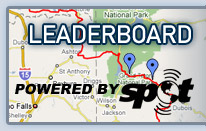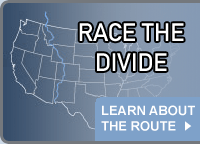TD Rule #4 FAQs
Rule 4 reads...
Advancing (forward) on the route by any means other than your own pedal power is strictly prohibited. No drafting. Use of any type of air scoop or umbrella sail intended to harness wind power is also prohibited. TD is a solo challenge, however, racing in the company of other racers is permitted provided all racers maintain separate gear. One complete survival kit per racer.
In the event of a serious mechanical or medical emergency that renders a bike unrideable, a rider may hitchhike[3] by motor vehicle in ANY direction to repair the problem. The location of the incident must be well documented by SPOT tracking or other GPS logger. A rider may also receive assistance returning back to the exact location of the breakdown to begin forward progress. Again, the entire incident, from breakdown to return to the route must be fully documented by GPS.
Endnote:
[3] A challenger may ONLY accept motor vehicle assistance off/back to route from bystanders and passersby or, in the case a commercial transportation source is available. 'Bystander/passersby' refers to purely coincidental encounters. A racer may not accept a ride from a race spectator (a.k.a 'super fan') or contact friends and/or family (private parties) living along the route for direct assistance.
FAQs: If you have an FAQ re. Rule 4 not answered below, post it using the comment form.







Comments
moving forward
What constitutes "forward on route"? If my bottom bracket seizes up 30 miles prior to Helena and I hitch a ride into Helena, not following or crossing the official GDMBR route, get the problem fixed, and return to where I left the route and continue, is that OK? If not, how far away from the route (forward) is considered "directly off route" rather than "forward on route"?
Re. moving forward
Good question, Bob. The direct answer to your above hypothetical is, "yes, that scenario is fine". As TD interprets the original 1999 rule, you can even cross the GDMBR en route to help.
'Off-route' means lateral movement on a side road or trail away from the designated route. Occasionally off-route movement is more advantageous than backwards movement. At the point your bike is not rideable, it's all going to be a crap-shoot. It may be faster to hoof it forward to the next possible town or available off-route road than to hitchhike backwards.
This rule can be a bit problematic to think about in the depths of trailside fatigue so it's important to be clear on it. How well one chooses can be the difference in hours or days of time lost and even relegation--or not. FWIW, the original intent of prohibiting forward (on-route) hitchhiking is A) to ensure a challenger rides the entire GDMBR (one cannot cheat, i.e. fudge a re-start when only hitchhiking backwards), B) to prevent the reconnaissance of the route ahead and C) to penalize a rider for getting in a car.
Advancing (forward) on the route by any means other than your ow
Advancing (forward) on the route by any means other than your own pedal power is strictly prohibited.
Surely it's permissable to walk at times!?!
Re. Advancing Fwd.
Thanks Paul.
Definition 6. for 'pedal', in dictionary.com is "of or pertaining to a foot or the feet".
We consider walking as pedal power.
Cheers.
Post new comment